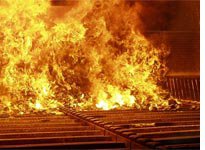
Waste incineration does not eliminate the need for landfills. When mixed municipal waste is burned in an incinerator it does not disappear completely. A large amount of solid residue called bottom ash is left behind. This is about 30 per cent of the original weight of the waste and occupies 40-50 per cent of the space that compacted unburned waste would. This ash still has to be disposed of in landfill sites. Bottom ash may be toxic as it contains some of the heavy metals and dioxins present in the things that were burned. When it is landfilled these pollutants may eventually leak into groundwater from where it is virtually impossible to clean them up. Moreover in ash form, the toxins are more liable to leach than if they are in unburned waste.
Incinerator ash is extremely hazardous, containing dioxin and heavy metals such as lead, mercury, and cadmium. Ash landfills are a legacy of poison that must be monitored for eternity. They never can become non-toxic, because most of the toxic materials in them - the heavy metals - do not bio-degrade.
Fine particles and polluting gases are also left behind after combustion. These are caught in the chimney by filter systems and are called fly ash. Incineration does not simply make the toxic substances in waste disappear, as the filtration technology on incinerators improves (which helps to reduce the amount of toxic emissions to air), the concentration of toxic contaminants in the ash increases. Fly ash is especially toxic, and although there is less of it (about 3-5 per cent of the original waste by weight and about 5-15 per cent of all the ash produced), it has to be treated with great care. It is classified as special waste and has to be dealt with very carefully. Currently that means a double lined landfill in as dry a location as possible and every effort taken to reduce exposure to water and to capture and store lechate.
The US Environmental Protection Agency (EPA) has begun a series of tests to see how quickly ash leaches toxic lead and cadmium under "realistic" conditions.[2]
Pure, natural rainwater is slightly acid (pH of 5.6 or 5.7). Acid rain has an even lower pH (down to 4 or even 3). But even pure rainwater is sufficiently acidic to leach metals like lead and cadmium. However, modern incinerator ash contains not only the ash itself (the burned waste) but also the lime from the air pollution scrubber system. The lime is basic or alkaline (the opposite of acid); it has a high pH (10 or 11). The presence of the lime is sufficient to prevent slightly acidic rain from immediately leaching the metals out of incinerator ash. So long as the lime is present, rainwater will not leach the metals out; instead, the rainwater leaches the lime out. This leaching of lime reduces the pH of the ash; but eventually the lime will be completely leached out, the pH of the ash will drop dramatically, and rainwater will then begin to leach the metals out. U.S. EPA agrees with this analysis; indeed, the point is hardly arguable. As if to confirm the obvious, EPA recently experimented with ash and lime mixed; they poured slightly acidic water over it and measured the pH and the metals that were leached. Not surprisingly, few metals were leached because the whole concoction was so alkaline that it neutralized the acidic water. EPA concluded, "The results of these limited laboratory studies suggest that the alkalinity of municipal incinerator fly ash probably controls and determines the release of elements [metals] into leachate until this alkalinity is exhausted." Just what a chemist would predict.
The EPA tests showed that after nine washings with acid rain, the pH of the ash-plus-lime mixture dropped from 10.9 to 9.4 because the lime was being removed by each successive washing. This is also what one would expect, and the EPA said so. "However, due to time constraints the work was discontinued after nine extractions," said EPA, thus avoiding the need to state the inevitable result that the incineration industry doubtless doesn't want put to paper:
Slightly acid water (like natural rainwater or like acid rain) leaches out the lime from incinerator ash. Eventually the lime's alkalinity will be entirely exhausted; then the rain will leach the toxic metals quickly. It's only a matter of time, and nature has all the time in the world. The hazard from the metals in ash will not degrade with time--the hazard is eternal; and the phenomenon called rain certainly shows no sign of letting up. Short of heroic (and prohibitively expensive, and unproven) measures like deep burial in the earth, there seems to be no solution to this problem. Not making incinerator ash is the only affordable remedy in sight.
[1] EPA "Environmental Fact Sheet" [EPA/530-SW-90-029c] CHARACTERIZATION OF MUNICIPAL WASTE COMBUSTION ASH, ASH EXTRACTS, AND LEACHATES completed for the EPA by NUS Corporation of Gaithersburg, Md;
[2] Colleen M. Northheim, Alvia Gaskill, and Gail A. Hansen, & "Development of a Laboratory Test Method for Estimating Leachate Quality From Municipal Incinerator Ash Monofills"; In Theodore G. Brna and Raymond Klicius, eds., Vol. I of PROCEEDINGS INTERNATIONAL CONFERENCE ON MUNICIPAL WASTE COMBUSTION, HOLLYWOOD, FL, APRIL 11-14, 1989, pgs. 3b-39 through 3b-52. Ottawa, Cn: Minister of Supply and Services Canada, 1989. Catalog No. En 40-11/14-1989e
More information about incinerator ash:
http://www.ipen.org/ipenweb/documents/work%20documents/incineration_ash.pdf
More on the health concerns related to waste incinerators: